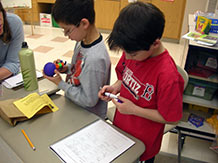What kind of material makes an object work well?
2. Choose and describe an object

Allow time for students to record the information about the windowpane and the spoon.
Students retrieve their personal or classroom object. They should record information for their object and at least one other object from their workgroup.
The following data is recorded in the table:
- the first column lists the name of the object.
- the second column lists the materials the object is made of.
- the third column lists any other materials that would allow the object to work well
- the fourth column lists materials that would be wrong for the object
Encourage students to share their entries with each other. Listen to how they are talking about materials, paying particular attention to whether they are distinguishing between objects and materials. Also, check to see if the students can organize information in the columns and rows of their table.
Ask a few (2–4) students with different objects to add their information to the class table.
Detours: Some students may become distracted by materials that appear in an object but are not obviously related to its usefulness or function. Glitter is an example. You can refocus attention on the primary material of manufacture, but you might also point out that the extraneous materials are also “useful” — e.g., for capturing a child’s attention or making the object “pretty.”



